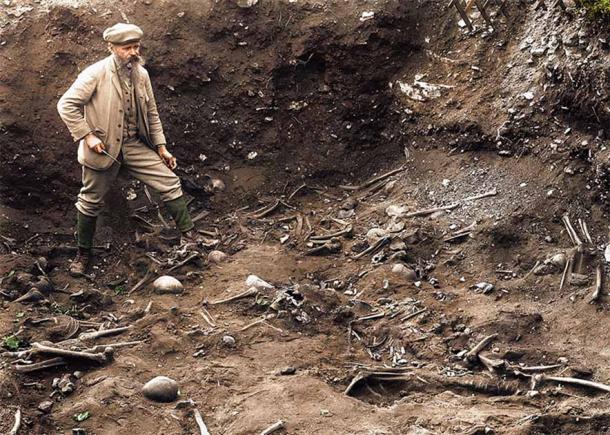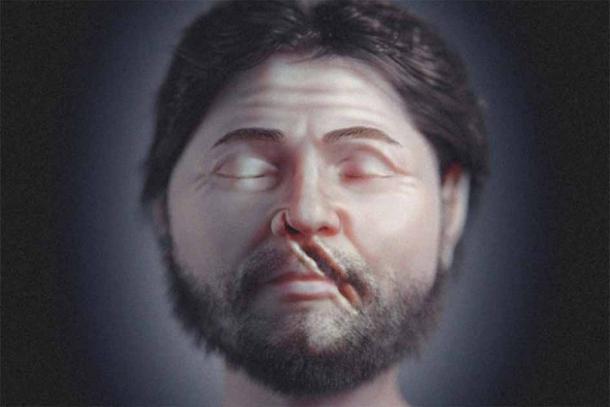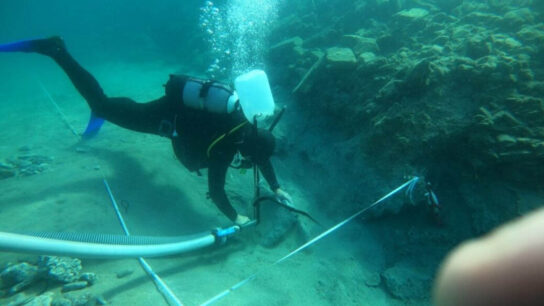Axe-Wounded Visby Warrior Brought to Life Over 600 Years Later
A medieval warrior’s skull, recovered from a mass grave outside Visby, a city on the Swedish island of Gotland, has been brought to life by a digital artist.
Killed in the 1361 AD Battle of Visby, in which 2,500 Danish warriors, mostly heavily-armed mercenaries, massacred 1,800 peasant farmers wielding farming tools, the warriors brutally broken face reveals the horrors of what is regarded as one of the most violent battles in European history.
Scientists took 3D scans of the skull revealing that his eye and cheekbones had been smashed with a pole weapon just before his mouth and nose were split open with an axe.
Using these 3D scans, and genetic statistical data, a digital artist has now brought this warrior back from the dead by recreating his heavily-wounded head and face.

Darkness Unfolding On the Fields of Gotland
On 22 July, 1361 AD, almost 2,000 residents of the Swedish town of Visby on the island of Gotland were slaughtered by 2,500 invading Danish troops. King Valdemar Atterdag of Denmark had just conquered the neighboring territories of Skåne and Öland, and he was greedy to subjugate Gotland.
A Gutnish yeomen army of peasant farmers and their families came head to head on July 27 with the Danish warriors outside Visby’s town walls, and around 1,800 peasant farmers wielding farming tools were quickly slaughtered.
Historians often equate this event with the 1356 AD Battle of Poitiers, when a similar number of French were brutally killed by an Anglo-Gascon force commanded by Edward, the Black Prince, during the Hundred Years’ War.

A Third of the Visby Defenders Were Young and Elderly
Since 1905, five mass graves have been identified outside Visby’s medieval town walls.
Most recently, archaeological excavations at one of these mass graves revealed the horrors of the slaughter when it was determined that “at least a third of the 1,800 poorly armed militia of farmers were children and elderly.”
Now, Brazilian digital artist Cicero Moraes has brought one of the Visby defenders back to life.
Moraes built his reconstruction using a three-dimensional model of the skull which was given to him by the Swedish History Museum in Stockholm. His creation was published in the 3D computer graphics journal OrtogOnLineMag.

Charting Ancient War Wounds
It is thought that shattered bones above the warrior’s left eye and on his left cheekbone were most probably inflicted by a heavy pole weapon. Furthermore, the man’s mouth and nose were smashed by an axe.
Once these bone wounds had been charted by digital scans, Moraes set “soft tissue thickness markers” across the entire skull. These pins determined the position of the warrior’s muscles and skin.
While the warrior’s skull forms the frame of the digital recreation, the sizes of his mouth, nose, and eyes are approximations based on the averages given by statistical data. Moraes said that once the man’s face was defined, “approximations generated the most scientifically accurate image” in shades of gray, with eyes closed and without hair.

The Townsfolk Gave Everything to Avoid Getting Axed
Attempting to stop the massacre, after the main Battle of Visby the militia of farmers and their families surrendered to the Danish warriors. To save their city from being sacked the Gotlanders handed over a large amount of their wealth to the invading King Valdemar. However, Valdemar appointed sheriffs and one year later added King of Gotland to his list of titles.
According to John Keegan’s 1976 book The Face of Battle, about 2,000 of the bodies of these city defenders were “unusually, buried in their armor.”
The author concluded that “hot weather and the great number of dead (2,000) inspired the Danish to strip them before decomposition began.” The site of the excavation, according to Keegan, has yielded “one of the most fearsome revelations of a medieval battle known to archaeologists.” Moraes’ facial reconstruction of an axe-wounded warrior brings this event to life.




